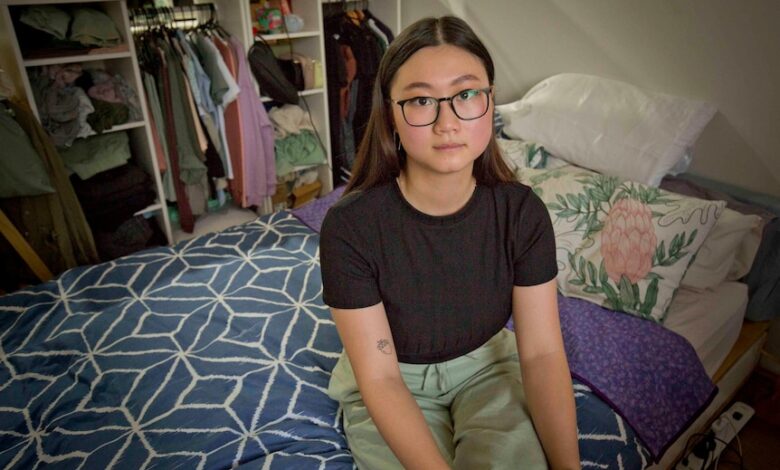Children leaving out-of-home care will soon get more support, but the old policy has left a stark legacy

By social affairs correspondent Norman Hermant
Teresa was forced to leave state care when she turned 18, and had to find a new home on her own.(ABC News: Mary Lloyd)
It’s hard to imagine a busier and more stressful year than what Teresa has just had.
Key points:
- All children leaving out-of-home care will be eligible for support beyond the age of 18
- Advocates say more help is needed to address inequalities with other young people
- Out-of-home care includes residential care, foster homes and kinship care
She left residential care and moved into an apartment she found on her own.
She completed New South Wales’ Higher School Certificate exams and has started university studies.
She got a retail job to support herself.
Teresa has lived in and out of residential care with other young people since she was 13.
And she faced those big milestones in her final year of high school virtually alone.
“There were just a lot of times where I felt really alone and I didn’t know where to turn when I needed help,” Teresa said.
“[I] needed help adulting, needed help at school, needed help with HSC, and just figuring out life on your own.”
Teresa moved into her own apartment before she turned 18, while juggling her HSC studies.(ABC News: Mary Lloyd)
In 2022, Teresa was one of the roughly 50,000 young people who lived in out-of-home care.
Out-of-home care arrangements include foster homes, residential care, and kinship care where children live with extended family.
Until recently, young people in out-of-home care were essentially cut off from support payments and case workers when they turned 18.
For Teresa, that meant she was due to lose her spot in residential care during her final year of high school.
“My life was so different to all of my friends,” she said.
“All of my friends … still do live at home. They were going to school surrounded by a supportive family and siblings.
“They didn’t need to go to an HSC exam and then come home and have a rental inspection, do the groceries, pay a bill and then study and have an exam the next day.”
3,000 youths ‘terminated’ by system each year
Starting this month, young people like Teresa will be given more help to navigate the transition to adulthood.
After a long campaign by advocacy services, all states and territories have announced plans to extend support to young people leaving out-of-home care up to the age of 21.
New South Wales, the last state to announce its plans, has introduced an Independent Living Allowance of $250 per fortnight for those up to the age 21 who have left out-of-home care.
Victoria’s equivalent payment is $500.
Queensland’s extended care measures will start from July.
Teresa will be eligible for NSW’s newly-announced support, but didn’t receive any help last year.(ABC News: Mary Lloyd)
Crucially, all states and territories will provide some sort of case worker support so that face-to-face contact doesn’t stop when out-of-home care leavers turn 18.
Before these measures, about 3,000 young people were “terminated” by out-of-home care systems before their 18th birthday each year, according to Anglicare Victoria’s Paul McDonald.
“Not many people quite realise that,” said Mr McDonald, who helped lead the long-running Home Stretch campaign to extend out-of-home care until the age of 21.
“The ‘formal parenting’, if I could put it like that, and the formal resourcing — an investment into that child by the state — all just finished.”
Policy leaves legacy of inequality
The policy of cutting off children in out-of-home care when they turn 18 has led to terrible outcomes.
More than one in three young people who left state care experienced homelessness during their first year out of the system. According to Home Stretch, within four years, more than half need help from homelessness services.
Within a year of leaving out-of-home-care:
- 39pc are homeless
- 46pc of boys and 22pc of girls are in the criminal justice system
- 54pc have mental health issues
- 17pc are pregnant during adolescence
- 29pc are unemployed
Out-of-home care leavers are also half as likely to complete year 12, three times more likely to be unemployed, and experience up to five times the rate of teen pregnancy.
On top of all of that, many out-of-home care leavers also go directly into the youth justice system or face serious mental health issues, said Philip Mendes from the Department of Social Work at Monash University.
“The picture is not good … if you compare what happens for the young people who’ve been in care to the majority of young people in the community,” he said.
Professor Mendes said having nationally-consistent support was a step in the right direction, but believes more could be done.
“The fact that in every jurisdiction now we’ve got a housing allowance and we’ve got casework support is massively important,” he said.
“What we need to do beyond that is to look at [whether] the support provided [is] enough — is it adequate?”
More can be done to help, advocates say
Now that state and territory governments have increased their support to out-of-home care leavers, advocates are calling on the federal government to step up too.
Out-of-home care leavers are eligible for Youth Allowance, which pays $562 per fortnight up to age 21, and a one-time federally funded Transition to Independent Living Allowance (TILA) of $1,500.
But advocates say that is inadequate for young people who essentially have no other support, and want the TILA increased to a yearly payment from ages 18 to 20.
The Department of Social Services said it is reviewing different funding approaches, with recommendations expected to be delivered to the department in 2024.
Given the disproportionate rate of homelessness faced by out-of-home care leavers, advocates also want more support to help these young people keep a roof over their heads.
Shauna Grammatikos, 22, believes her experience shows just how valuable extra support could be for those leaving out-of-home care.
In 2021, Shauna Grammatikos left her foster home and moved into housing run by COMPASS.(ABC News: Norman Hermant)
She’s part of the pilot COMPASS program run by Anglicare Victoria that links out-of-home care leavers with case workers, and places them into homes owned by the charity.
She said having someone to help her budget, work out how to pay rent and bills, and figure out what she needed for her new home was enormously helpful.
“I feel like if people actually had the help, like the support that they need … there wouldn’t be a lot of young people out on the street,” she said.
Teresa didn’t get have any support of this kind when she left state care.
Despite this, she placed in the top 20 per cent in her ATAR university entrance exams and made it into the faculty she wanted: social sciences and law at the University of New South Wales.
Teresa has settled into university life and living alone, despite the challenges.(ABC News: Mary Lloyd)
She’s learned to keep track of household bills, rent, car rego and petrol, and school costs.
She’s still doing this almost entirely on her own at age 18, and she wants that to change.
“There definitely needs to be greater, more intensive support,” she said.
“More … programs for people who just need to know that someone is there.”




